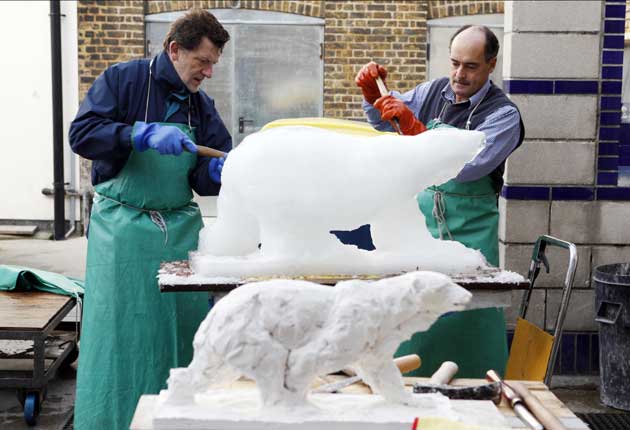Climate change: The ice bear cometh
A life-size sculpture will appear this week to carry a chilling message about climate change. Rob Sharp finds out how it's made

With his chisel, sculptor Mark Coreth chips a tiny shaving from a block of ice. As he moves around the brick, lopping off chunks and polishing corners, rudimentary features begin to emerge. First, the form of a muscular back; then the crystalline outline of a ferocious snout; a pearly outstretched leg.
Ice sculptures summon up an image of decadent parties or glossy adverts for alcoholic drinks. But this week, one frozen statue – of a 1.8-metre-high polar bear – is set to promoting a more important cause.
With his icy bear, Coreth hopes to make a dramatic statement to mark this week's climate change talks in Copenhagen. On 4 December the animal sculptor will work with a team of helpers to create a life-sized polar bear from a nine-tonne block of ice in central Copenhagen's Nytorv Square, a short distance from the city's Bella Centre, where governments from across the globe will debate emissions targets. The feat will be achieved in a single morning, with the stunt being repeated in London's Trafalgar Square on 12 December.
"I wanted to explore the Arctic environment and the polar bear is such a wonderful way of doing that," says Coreth. "What's happening in the Arctic is abhorrent; this isn't just a sculpture of a polar bear. It's a sculpture of an entire environment."
According to research published late last month by international conservation charity the World Wildlife Fund (WWF), all of the Arctic's summer ice will disappear within around 20 years. This will have a devastating affect on polar bear communities, which live on ice all year round.
An admirable cause; but just how do you carve an animal from ice? Inspired by his enthusiasm, I visit the Wimbledon studio of Duncan Hamilton, an experienced ice sculptor who is advising Coreth. On the day of my visit, Coreth is working on his first practice run-through of the bear, with a small block of ice. He carves out great chunks with a chainsaw before hammering at it with a chisel. Tentatively, I take up a chisel and try it for myself. Duncan recommends working from a sketch (in this case we use a Plasticine model previously made by Coreth), and the ice splinters satisfyingly.
"It's easy to push it too hard," Hamilton advises, with one eye on my bad technique. "It requires immense physical and mental concentration. You need to work on the whole piece, not part by part, because if you focus too closely on something, things will happen elsewhere without you realising. It evolves. It's always a bit different to how you originally envisaged it."
Coreth, who is being funded by the Arts Council and National Lottery and working with wildlife experts from the WWF, came up with the idea for the Ice Bear Project in May when travelling to northern Canada to study polar bear communities. Coreth visited Pond Inlet, a remote Inuit community on Canada's north coast. After several days spent trekking, the sculptor finally managed to spot a solitary polar bear, and his inspiration was frozen into place.
"He was hunting a baby seal," the sculptor now explains. We watched and studied and enjoyed. After some time we managed to get a bit closer and we ended up chasing him, somewhat unwittingly."
While in Pond Inlet, Coreth sculpted several polar bear models out of wire and Plasticine. Upon returning to his base in Tisbury near Wiltshire, the artist copied these and used research he conducted at Oxford University's Museum of Natural History to fashion two life-sized skeletons of polar bears out of bronze (one for London, one for Copenhagen) using the "lost wax" method in which molten bronze is injected into a wax mould.
Working in a deep freeze in Stanmore last weekend, Hamilton placed the skeletons in a pair of tall wooden boxes. He built up ice around them, by pouring water into the boxes, one layer at a time. He was then left with two blocks of ice with bronze skeletons embedded in them. Once the ice sculptures have been carved and left out in the public square this week, the bears will gradually disintegrate, revealing the bronze skeletons inside them (the transience of ice versus the permanence of bronze).
So will Coreth be dismayed to see his hard work melt away? Not a bit of it. "I feel incredibly lucky to work with something so fragile and impermanent," he explains. "I don't feel a sadness that the ice will be gone, because that is part of the message behind it."
Join our commenting forum
Join thought-provoking conversations, follow other Independent readers and see their replies
Comments
Bookmark popover
Removed from bookmarks